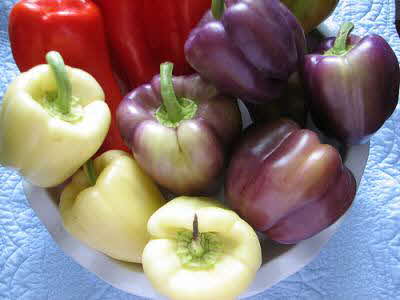See also: Article on Sweet Peppers - Chili Peppers
For information on ‘Green Pepper Mangoes’ see Mangoes
PEPPERS: FACTS and TRIVIA
Sweet Peppers
Green, sweet bell pepper have 2 times as much vitamin C as oranges; red and yellow bell peppers have 4 times as much.
Chili Peppers
The seeds are NOT the hottest part of peppers. It is at the point where the seed is attached to the white membrane inside the pepper that the highest concentration of capsaicin (the compound giving peppers their pungent flavor) is found.

Question. If you leave green peppers on the vine do they turn red? Where do orange and yellow peppers fit in. Do they all start green or are they from different seeds?
Answer. Sweet bell peppers can be orange, yellow, red, purple, brown, black, ivory or green, depending on the stage of ripeness and the variety.
Green bell peppers are fully developed, but not ripe.
All sweet bell peppers start out green, and change color as they ripen. (They also get sweeter).
What can be confusing, is that there is also a variety that is green when ripe.
The color depends on the specific variety, the most common variety is red when ripe.
So--- Green sweet bell peppers start out green and are green when ripe.
Red, yellow, etc. sweet bell peppers start out green and turn red when ripe.
What you find in the store are usually either unripe green sweet bell peppers or unripe red ones.
They will not be any of the other color varieties in the green stage because the other colors can be sold at a much higher price, so they are always allowed to ripen before being sold. The additional time it takes to ripen and change color accounts for part of the reason they are more expensive. Also, since they are ripe, they have a shorter storage time.
January 2005 e-mail question
Question. I was just told today that when choosing bell peppers I should look for one with four bumps on the bottom because it is a "female" pepper and thus will be sweeter. The "male" pepper has only three bumps. Is this factual???
Answer. Peppers have complete flowers, that is both male and female parts in the same flower. *
Male and female fruit can only come from plant types that have separate male and female flowers, and with a few exceptions, only the female flowers produce fruit. (one of the exceptions - some papaya male flowers will set fruit).
The number of lobes is related to the specific variety of pepper. There are varieties of peppers that produce 2, 3-4, or 3-5 lobed peppers. The 4 lobed 'bell' pepper was (and is) more popular in the U.S., so plants have been breed for this characteristic.
* (Pepper trees [black & white pepper] have separate male and female flowers).
You are here > Home > FOOD TRIVIA & FACTS >
Also see: Food Articles and Cooking Tips
FREE Magazines
and other Publications
An extensive selection of free magazines and other publications
FOOD TRIVIA and FOOD FACTS
Please feel free to link to any pages of FoodReference.com from your website.
For permission to use any of this content please E-mail: james@foodreference.com
All contents are copyright © 1990 - 2025 James T. Ehler and www.FoodReference.com unless otherwise noted.
All rights reserved. You may copy and use portions of this website for non-commercial, personal use only.
Any other use of these materials without prior written authorization is not very nice and violates the copyright.
Please take the time to request permission.
Popular Pages
CULINARY SCHOOLS
& COOKING CLASSES
From Amateur & Basic Cooking Classes to Professional Chef Training & Degrees
Home | Articles | FOOD TRIVIA | Today in Food History | Food Timeline | Recipes | Cooking_Tips | Food_Videos | Food Quotes | Who’s Who | Culinary Schools & Tours | Food_Trivia_Quizzes | Food Poems | Free_Magazines | Food Festivals & Events
FoodReference.com (since 1999)
FOOD TRIVIA and FOOD FACTS SECTION
